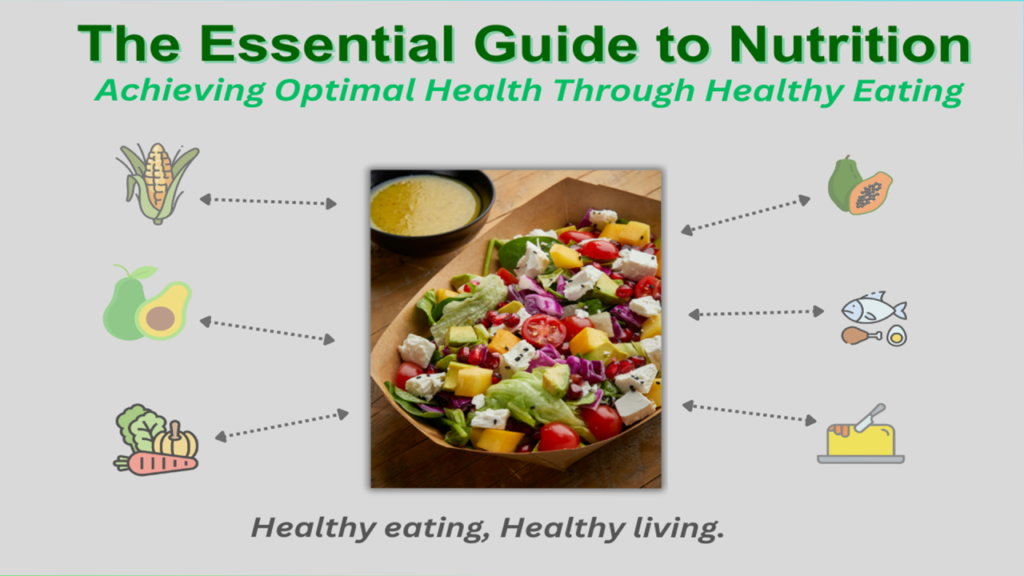Learn the fundamentals of healthy eating with this comprehensive guide. Discover tips on balanced diets, nutrient-dense foods, and practical strategies for a healthier lifestyle.
Introduction to Healthy Eating
Healthy eating is the cornerstone of a long, vibrant, and disease-free life. The food choices we make directly impact on our physical health, mental well-being, and overall quality of life. Importantly, a nutritious diet can help prevent chronic illnesses such as heart disease, diabetes, and obesity while boosting energy levels and improving mood.
This guide will explore the basics of healthy eating, including the importance of balanced meals, nutrient-dense foods, portion control, and practical strategies to make healthy eating a sustainable habit.
Why Healthy Eating Matters
To begin with, adopting a healthy diet is one of the most effective ways to improve your overall health. According to research, premature heart disease and stroke can be prevented through healthy lifestyle choices, including proper nutrition. Moreover, a balanced diet supports weight management, reduces inflammation, and strengthens the immune system.
Key Benefits of Healthy Eating:
- Improves cholesterol levels.
- Reduces blood pressure.
- Helps maintain a healthy weight.
- Controls blood sugar levels.
- Lowers the risk of chronic diseases such as cancer and diabetes.

The Core Principles of Healthy Eating
1. Balance Your Plate
A balanced plate ensures that your body receives the nutrients it needs to function optimally. Notably, many health organizations recommend dividing your plate into three main sections:
- Half the plate: Fruits and vegetables for vitamins, minerals, antioxidants, and fiber.
- One-quarter: Whole grains for sustained energy.
- One-quarter: Protein sources like fish, chicken, beans, or tofu for muscle repair and growth.
2. Focus on Nutrient-Dense Foods
Nutrient density refers to foods that are rich in vitamins, minerals, and other essential nutrients relative to their calorie content. For example:
- Vegetables like spinach and broccoli are low in calories but high in nutrients.
- Nuts and seeds provide healthy fats alongside essential vitamins.
3. Limit Processed Foods
Processed foods are often high in added sugars, unhealthy fats, and sodium. Instead, opt for whole or minimally processed foods such as fresh fruits, vegetables, whole grains, lean proteins, and healthy fats.
Key Components of a Healthy Diet
1. Fruits and Vegetables
Fruits and vegetables should make up at least half your plate at every meal. They are packed with essential nutrients like vitamins C and A, potassium, fiber, and antioxidants.
Tips for Including More Fruits & Vegetables:
- Aim for at least five servings per day (around 400g).
- Choose a variety of colors to maximize nutrient intake (e.g., leafy greens, orange carrots).
- Use frozen or canned options when fresh produce is unavailable.
2. Whole Grains
Whole grains like oats, quinoa, brown rice, and whole wheat bread are excellent sources of fiber and B vitamins. They help improve digestion and provide long-lasting energy.
Healthy Whole Grain Choices:
- Replace white bread with whole-grain bread.
- Use brown rice instead of white rice.
- Incorporate oatmeal or quinoa into breakfast bowls.
3. Protein-Rich Foods
Protein is essential for building muscles, repairing tissues, and supporting overall body functions. Include a mix of plant-based proteins (e.g., beans, lentils) and animal-based proteins (e.g., fish, eggs).
Protein Tips:
- Eat at least two servings of fish per week (preferably fatty fishlike salmon for omega-3 fatty acids).
- Choose lean meats like chicken or turkey without skin.
- Incorporate plant-based proteins like tofu or chickpeas into your meals.
4. Healthy Fats
Not all fats are bad! Unsaturated fats found in avocados, nuts, seeds, olive oil, and fatty fish are beneficial for heart health.
Avoid: Trans fats found in fried foods or packaged snacks.
Include: Omega-3-rich sauces like walnuts or flaxseeds.
5. Hydration
Staying hydrated is just as important as eating nutritious food. Aim for 6–8 glasses of water daily to support digestion and overall health.
Tips for Staying Hydrated:
- Carry a reusable water bottle wherever you go.
- Replace sugary drinks with water or unsweetened beverages like herbal tea.

Practical Strategies for Healthy Eating
Plan Your Meals
Meal planning helps you make healthier choices while saving time during busy weeks. For example, plan meals around nutrient-dense ingredients like vegetables or whole grains.
Practice Portion Control
Understanding portion sizes can prevent overeating:
- Use smaller plates to control portions visually.
- Follow serving size recommendations on food labels.
Make Gradual Changes
Healthy eating doesn’t have to be overwhelming. Start small by incorporating one nutritious meal per day or swapping out unhealthy snacks for healthier alternatives like nuts or fruit.
Cooking at Home More Often
Preparing meals at home gives you control over ingredients:
- Use herbs instead of salt for flavor.
- Experiment with different cooking methods like steaming or grilling instead of frying.
Common Myths About Healthy Eating
- Myth: Healthy eating is expensive.
Fact: Buying seasonal produce or bulk whole grains can save money while providing nutritious options. - Myth: All fats are bad.
Fact: Unsaturated fats from avocados or nuts are essential for good health. - Myth: Carbs should be avoided completely.
Fact: Whole grains are an important source of energy when consumed in moderation.
Adapting Healthy Eating to Your Lifestyle
Healthy eating isn’t one-size-fits-all—it depends on factors like age, activity level, cultural preferences, and dietary needs:
- For athletes: Focus on protein-rich meals post-workout.
- For vegetarians/vegans: Ensure adequate intake of plant-based proteins like lentils or tofu.
- For older adults: Prioritize calcium-rich foods for bone health.
The Role of Mindful Eating
Mindful eating involves paying attention to hunger cues and savoring each bite without distractions:
- Eat slowly to recognize when you’re full.
- Avoid multitasking while eating (e.g., watching TV).
- Focus on the flavors and textures of your food.
Moreover, mindful eating can help reduce overeating while fostering a healthier relationship with food.
Emerging Trends in Healthy Eating
Furthermore, advancements in technology and nutritional science are transforming how we approach healthy eating:
- Personalized Nutrition: Genetic testing helps tailor diets based on individual nutritional needs.
- Plant-Based Diets: Increasingly popular for their health and environmental benefits.
- Sustainable Eating: Choosing locally sourced and organic foods to reduce environmental impact.
Actionable Steps for Better Nutrition
- Schedule a weekly grocery trip to stock up on fresh produce and whole grains.
- Start a meal prep routine to ensure healthy meals throughout the week.
- Incorporate one new nutrient-dense food into your diet each week.
- Set achievable goals for reducing processed foods.
- Practice mindful eating by turning off screens during meals.

Additional Strategies for Healthy Eating
Integrative Therapies
Moreover, integrative therapies such as acupuncture and herbal supplements may offer additional benefits for some individuals. Notably, while these therapies are not a replacement for conventional nutrition advice, they can complement traditional methods when used under professional guidance.
Educational Resources
Furthermore, accessing educational resources is crucial for staying informed about healthy eating. Websites from reputable health organizations and nutrition support groups can provide valuable information and support. In addition, attending workshops or seminars on nutrition can offer practical tips and insights from experts.
Community Engagement
Importantly, engaging in the community can provide emotional support and practical advice. Joining local nutrition support groups or participating in online forums can connect individuals with others who share similar experiences. Moreover, this sense of community can enhance overall well-being and provide a network of support during challenging times.
Conclusion: Building a Sustainable Approach to Healthy Eating
Healthy eating is not about perfectionists making consistent choices that nourish your body while allowing room for enjoyment. By focusing on balance, nutrient-dense foods, portion control, and mindful habits, you can create a sustainable approach to nutrition that supports long-term wellness.
Ultimately, small changes lead to big results over time. Start today by incorporating one new healthy habit into your routine—your body will thank you!

The Role of Technology in Nutrition
In conclusion, technology is revolutionizing nutrition by providing accessible tools for tracking health metrics and connecting with nutrition professionals remotely. Apps like MyFitnessPal help monitor daily nutrient intake, while telemedicine services offer convenient consultations.
The Importance of Community Support
Moreover, community support plays a vital role in maintaining a healthy diet. Joining support groups or online forums can provide emotional support and practical advice from others who share similar experiences.

